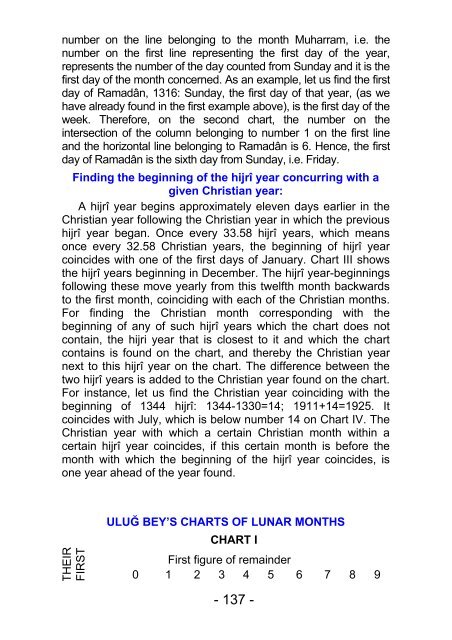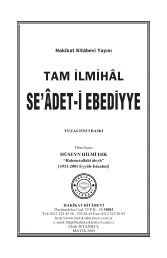5-Endless Bliss Fifth Fascicle - Hakikat Kitabevi
5-Endless Bliss Fifth Fascicle - Hakikat Kitabevi
5-Endless Bliss Fifth Fascicle - Hakikat Kitabevi
Create successful ePaper yourself
Turn your PDF publications into a flip-book with our unique Google optimized e-Paper software.
number on the line belonging to the month Muharram, i.e. the<br />
number on the first line representing the first day of the year,<br />
represents the number of the day counted from Sunday and it is the<br />
first day of the month concerned. As an example, let us find the first<br />
day of Ramadân, 1316: Sunday, the first day of that year, (as we<br />
have already found in the first example above), is the first day of the<br />
week. Therefore, on the second chart, the number on the<br />
intersection of the column belonging to number 1 on the first line<br />
and the horizontal line belonging to Ramadân is 6. Hence, the first<br />
day of Ramadân is the sixth day from Sunday, i.e. Friday.<br />
Finding the beginning of the hijrî year concurring with a<br />
given Christian year:<br />
A hijrî year begins approximately eleven days earlier in the<br />
Christian year following the Christian year in which the previous<br />
hijrî year began. Once every 33.58 hijrî years, which means<br />
once every 32.58 Christian years, the beginning of hijrî year<br />
coincides with one of the first days of January. Chart III shows<br />
the hijrî years beginning in December. The hijrî year-beginnings<br />
following these move yearly from this twelfth month backwards<br />
to the first month, coinciding with each of the Christian months.<br />
For finding the Christian month corresponding with the<br />
beginning of any of such hijrî years which the chart does not<br />
contain, the hijri year that is closest to it and which the chart<br />
contains is found on the chart, and thereby the Christian year<br />
next to this hijrî year on the chart. The difference between the<br />
two hijrî years is added to the Christian year found on the chart.<br />
For instance, let us find the Christian year coinciding with the<br />
beginning of 1344 hijrî: 1344-1330=14; 1911+14=1925. It<br />
coincides with July, which is below number 14 on Chart IV. The<br />
Christian year with which a certain Christian month within a<br />
certain hijrî year coincides, if this certain month is before the<br />
month with which the beginning of the hijrî year coincides, is<br />
one year ahead of the year found.<br />
THEIR<br />
FIRST<br />
ULUĞ BEY’S CHARTS OF LUNAR MONTHS<br />
CHART I<br />
First figure of remainder<br />
0 1 2 3 4 5 6 7 8 9<br />
- 137 -











